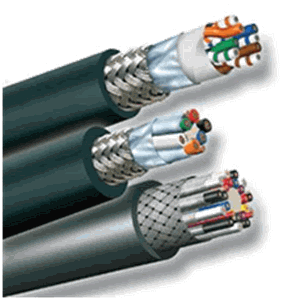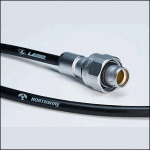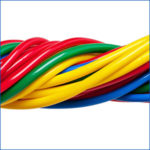High-Flex Versus High-Flex-Life Cable
High-Flex Versus High-Flex-Life Cable
 When your application calls for cable meant to stand the tests of time and motion, you need to know what to purchase and what constitutes product quality. Cable designed to survive 10 million to 20 million flexing cycles is high-flex-life cable. It’s different from high-flex cable, which is designed to be supple and highly flexible. High-flex-life cable may actually feel stiffer than high-flex cable. The two products are distinctly different and mutually exclusive.
When your application calls for cable meant to stand the tests of time and motion, you need to know what to purchase and what constitutes product quality. Cable designed to survive 10 million to 20 million flexing cycles is high-flex-life cable. It’s different from high-flex cable, which is designed to be supple and highly flexible. High-flex-life cable may actually feel stiffer than high-flex cable. The two products are distinctly different and mutually exclusive.
Try bending the cable, twisting it, pulling it, rolling it back and forth in a track, having it bear weight, rubbing it, and subjecting it to extremes of temperature and to solvents, oils, and chemicals. Now do these things 10 million times in continuous motion, without ceasing. You’ll learn the difference between high-flex-life and high-flex cable quickly — one cable isn’t the same as the other.
Once you’ve established that high-flex-life cable is appropriate for your application, you face the dilemma of choosing a supplier. Is high-flex-life cable a commodity, or does it really matter which supplier you choose?
The productivity of your automated equipment depends on the right cable choice. When the cable is one part of many in automated equipment, failure of the cable means failure of the entire process. It’s a critical component in your manufacturing, and you need to know what you’re getting for your money when you source cable suppliers.
How do you know if a cable will successfully meet your particular needs?
Look beyond your needs. The success of high-flex-life cable in demanding applications isn’t enough. Success is defined by surpassing demanding applications. The success of high-flex-life cable in surpassing the most demanding applications isn’t dependent on the most expensive materials. Success is achieved by superior design: products designed to perform with constant bending, rolling, and twisting, not products that happen to pass tests developed to meet minimum standards. And the true test of high-flex-life cable is failure; cable that is tested to the point of failure and analyzed, reengineered, and retested can result in an even stronger product.
Does your cable surpass demanding applications and meet superior design specifications?
Exceeding Demands
In today’s automated environments, if a cable fails even once, that means shutting down the line and losing money. A cable that is tested and proven to not only meet intended applications but also tested and proven to go beyond those applications is a powerful preventative measure against failure. Northwire has continuously flexed cables for as long as three years, for more than 36 million flexes. While 36 million flexes may never be required for your application, you’d rather not take a chance of failure at 10 million and one for a product that was only tested for 10 million flexes. Ask your cable supplier if products are tested beyond industry standards to the point of failure.
Another area to test beyond probable application is severity of conditions. It’s not enough to simply flex cable repeatedly. The cable must be stressed in various ways in the process, to not only mirror, but to surpass the harshest, most abusive conditions.
When your business depends on absolute reliability of components, a cable that meets the minimum or very basic standards of testing is insufficient. Maximum protection against cable-related failures results from stringent, prescient testing that foresees condition extremes and perils, and eliminates failure probability. Ask your cable supplier about stress elements of testing situations. In addition to flexing, are cables subjected to weight-bearing conditions during flexing? Are they twisted, torqued, rubbed, crushed, bent, and rolled?
Innovative Solutions
In the past, there was a school of thought in the industry that high-flex-life was dependent on expensive cable materials. That isn’t necessarily true. High-flex-life is dependent on design of products and tests. Cable shouldn’t be designed and then tested to ensure that it can withstand likely conditions. Instead, the most extreme conditions should be anticipated, testing developed to simulate and surpass them, then materials selected and cable designed to succeed in the most severe environments, such as being rolled over by heavy equipment; gnawed on by rodents; or bent, pulled, and alternately slackened 24 hours a day in a subzero environment. Although every severe condition cannot be duplicated exactly, testing can be standardized to simulate the actual severe stresses, and test procedures defined and made replicable. Ask your cable supplier about ongoing research and development, design of experiments, and test standard origins.
Details, Details
How much detail does your cable supplier provide about test specifications and results? A supplier should be transparent and willingly provide you with test verification and test reports, and even welcome you to the test environment to observe it firsthand. Any hesitancy to provide the requested level of detail is a red flag. Simply stating that cable is tested isn’t enough. Verifiable, thorough, intense testing adds value to a product. Just make sure the added value your supplier claims is bona fide. Ask your cable supplier for test specifications and performance data, including cycles completed. Showing a photograph of a testing process on a website isn’t enough.
*This white paper can be read in its entirety here.
- Facts & Figures: Semiconductor Market Grew to a Record $336 Billion - March 2, 2015
- TLC and Metz Ethernet Cat 6A Patch Cords in Seven Vibrant Colors - January 27, 2014
- Cables Unlimited LC-LC Duplex Ruggedized Fiber Jumpers - January 27, 2014







